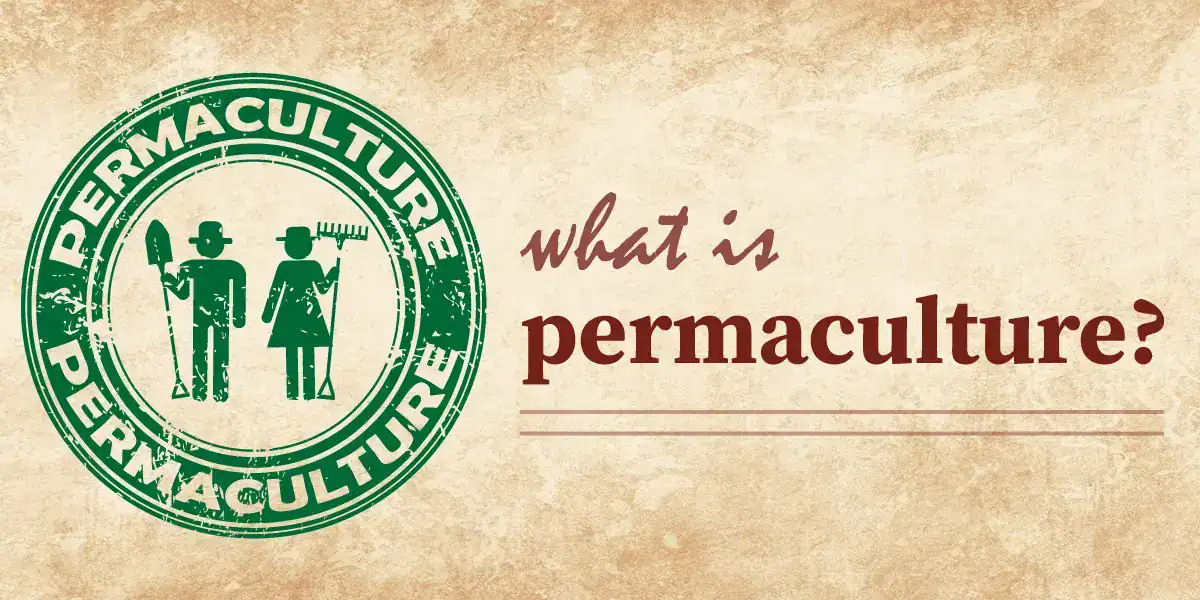Nothing lasts forever.
- Civilizations rise and fall — none have endured more than a few thousand years.
- The sun will run out of usable hydrogen in roughly 5 billion years.
- The Milky Way will collide with the Andromeda Galaxy in ~4 billion years, forming a new galaxy. Stick around for the show!
Nothing’s permanent, not even the planet that supports us.
Why, then, should we care about permaculture gardening, a debatable concept that combines “permanent” and “agriculture?”
Because, unlike traditional gardening, which relies on synthetic fertilizers and pesticides, permaculture mimics natural ecosystems, where plants, animals, and the environment work together in a self-sustaining system. The land we farm will remain fertile and productive for many generations.
For Southern California gardeners facing drought conditions and rising environmental concerns, permaculture can be a practical method of conserving water, building healthy soil, and producing abundant harvests.
Core Principles of Permaculture
Earth Care
- Respect and preserve natural ecosystems.
- Build soil health, conserve water, and enhance biodiversity.
- Regenerative practices rather than exploitative ones.
People Care
- Support community well-being and self-reliance.
- Ensure access to resources like healthy food, clean air, and shelter.
- Emphasize education and cooperation.
Fair Share (Return of Surplus)
- Share surplus (food, energy, knowledge) to benefit others.
- Limit consumption and redistribute resources to maintain balance.
- Reinforce sustainable feedback loops in nature and society.
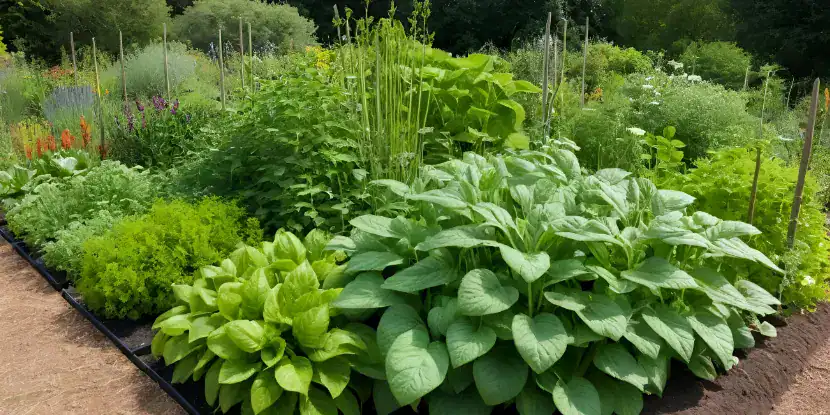
A densely planted permaculture garden.
The 12 Design Principles of Permaculture
These principles, courtesy of David Holmgren, guide the creation of permaculture systems:
- Observe and Interact: Watch how nature functions before taking action.
- Catch and Store Energy: Use rainwater, compost, solar energy, etc., to store resources when they’re abundant.
- Obtain a Yield: Design for productivity — ensure your garden provides food, medicine, or other benefits.
- Apply Self-Regulation and Accept Feedback: Learn from your mistakes; design systems that adjust themselves naturally.
- Use and Value Renewable Resources and Services: Prioritize solar, wind, plant-based materials, and natural processes.
- Produce No Waste: Everything is a resource; reuse, recycle, compost.
- Design from Patterns to Details: Use natural patterns (spirals, branching, zoning) to guide efficient layouts.
- Integrate Rather Than Segregate: Build relationships — plant guilds, companion planting, beneficial insect habitats.
- Use Small and Slow Solutions: Start small, grow gradually, and adapt to feedback.
- Use and Value Diversity: Promote resilience with biological and cultural diversity.
- Use Edges and Value the Marginal: The “edge” zones (like between forest and field) are the most productive and diverse.
- Creatively Use and Respond to Change: Anticipate and adapt to shifts in climate, community, and needs.
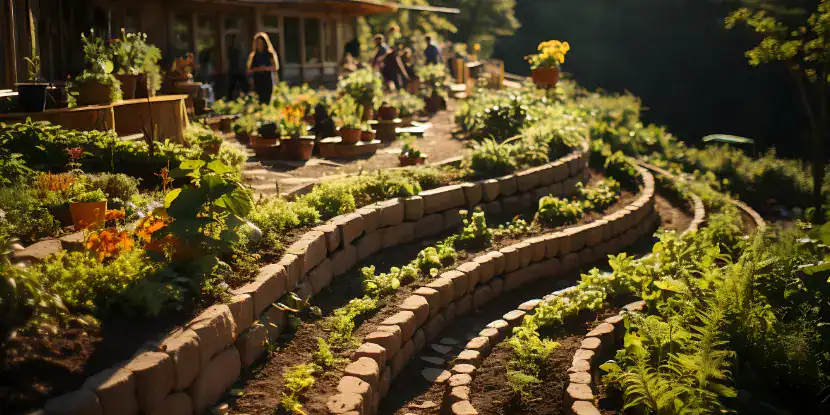
A tiered garden provides microclimates for various plant species.
Practical Applications in Gardening
No-Till Soil Building
No-till methods avoid turning the soil and build layers of organic material that decompose in place. Two popular techniques are sheet mulching and lasagna gardening.
Polycultures & Plant Guilds
Polycultures and plant guilds mimic natural ecosystems by growing multiple plant species together for mutual benefit. The “Three Sisters” method — a traditional Native American system — combines corn as a natural trellis, beans to climb the corn and fix nitrogen in the soil, and squash to sprawl on the ground, suppress weeds, and retain moisture.l fuels.
Perennial Crops
These form the backbone of permaculture systems. Fruit trees, berry bushes, and perennial herbs require less maintenance than annual crops while providing long-term yields. For Southern California, drought-tolerant options like pomegranates, figs, and Mediterranean herbs work exceptionally well.
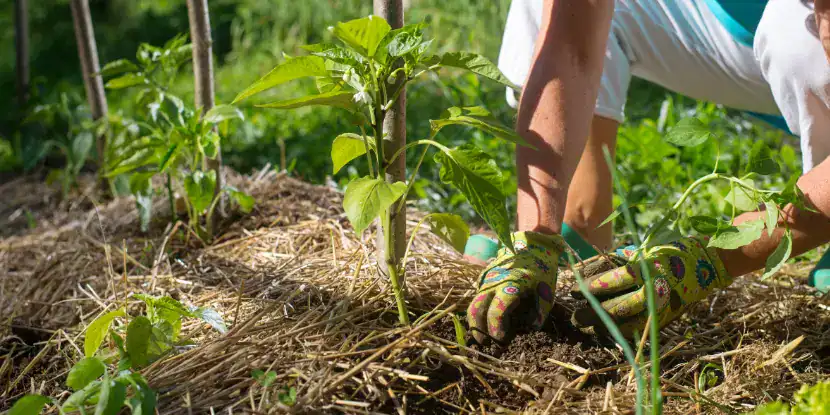
A sustainable garden with a thick layer of straw mulch.
Food Forests
Canopy trees provide shade and windbreak, understory trees offer mid-level production, shrubs fill gaps, herbaceous plants cover ground level, root crops utilize below-ground space, and climbing vines maximize vertical growing area.
Composting Systems
Composting systems transform organic waste into valuable soil amendments. Hot composting, vermicomposting, and composting toilets return nutrients to the soil while reducing waste sent to landfills.
Water Management
Rainwater harvesting, swales, and greywater systems maximize water efficiency and are particularly valuable for Southern California’s arid climate.
Getting Started with Permaculture
- Observe your site for at least one full season. Document sun patterns, water flow, soil conditions, existing vegetation, and microclimates. This information guides all future design decisions.
- Begin with simple projects like composting, rainwater collection, or companion planting. These foundational elements provide immediate benefits while you develop comprehensive plans.
- Choose plants appropriate for Southern California’s climate. Native and Mediterranean varieties perform well, as do drought-tolerant fruit trees, perennial vegetables, and water-wise herbs.
- Build soil health through composting, mulching, and cover cropping. Healthy soil supports plant growth while improving water retention and nutrient availability.
- Connect with the local community through permaculture groups, workshops, and online forums. Learning from experienced practitioners accelerates your progress while fostering long-term relationships.

Permaculture gardens can have a wild and almost unkempt look.
Popular Setups for Sustainable Gardening
1. Vertical Gardening
Best for: Small spaces, urban environments, balconies, fences
- Grows plants upward using structures like trellises, towers, and wall planters.
- Increases growing space and maximizes sunlight exposure.
- Can be done with various types of plants, including vegetables, herbs, and flowers.
2. Keyhole Garden Beds
Best for: Arid regions, food security gardens
- Features circular garden beds with a keyhole-shaped cutout for easy access to the center.
- Built with layers of organic matter and soil, which creates a self-watering system.
- Provides efficient use of water and nutrients while requiring minimal maintenance.
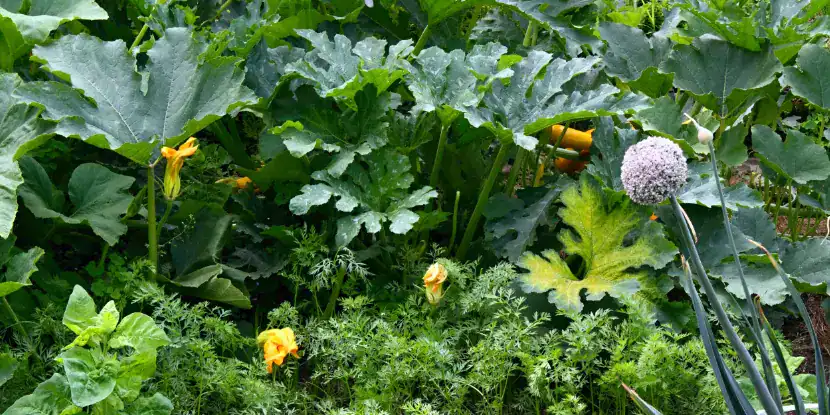
Squash leaves provide protection for more delicate plants.
3. Hügelkultur (Mound Beds)
Best for: Cold climates, heavy clay soils
- Raised garden beds are made from logs, branches, twigs, and other organic materials covered with topsoil.
- Creates a nutrient-rich environment that retains moisture and provides long-term fertility.
- Can be used for both annual and perennial plants.
4. Forest Gardens
Best for: Larger plots, long-term productivity
- A low-maintenance and sustainable approach to gardening that mimics a natural forest ecosystem.
- Combines fruit and nut trees, shrubs, herbs, vegetables, and other plants in multiple layers.
- Plant layers provide nutrients, shade, support, and pest control.
- Offers a variety of food sources for humans and wildlife while promoting biodiversity.
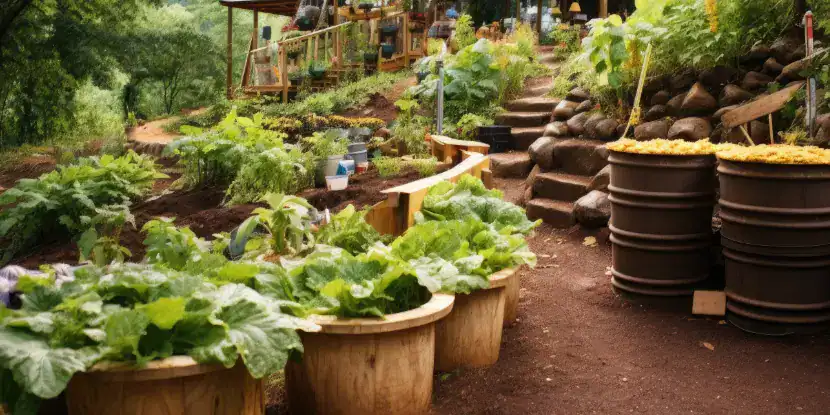
Containerized plants are easy to move to take advantage of conditions.
5. Container Gardening
Best for: Urban dwellers or gardeners with limited outdoor space
- Perfect for balconies, rooftops, patios, or small indoor spaces.
- Uses containers such as pots, buckets, boxes, or hanging baskets to grow plants.
- Can be easily moved and rearranged for optimal sunlight and space efficiency.
- Ideal for growing herbs, vegetables, and small flowering plants.
6. Wicking Beds
Best for: Areas with water scarcity or irregular watering
- Uses a self-watering system to reduce water usage and maintenance.
- Consists of a reservoir at the bottom that wicks water up to the plant roots, providing consistent moisture.
- Can be made from materials such as recycled containers or raised garden beds with a wicking layer.
- Ideal for thirsty plants like leafy greens and herbs.
7. Lasagna Gardening (Sheet Mulching)
Best for: Building soil on top of poor-quality or compacted ground
- Involves layering organic materials, such as newspaper, cardboard, compost, and straw, to create a raised bed.
- The layers decompose over time, adding nutrients to the soil and creating a fertile plant environment.
- Can be done directly on top of grass or weeds without tilling or digging.
8. Spiral Herb Gardens
Best for: Limited space and easy access to herbs
- Stones or bricks build the walls of a spiral-shaped garden.
- As the spiral rises, it creates different microclimates suitable for different types of herbs.
- Can also be built with a central pole or trellis to grow climbing herbs like rosemary and thyme.
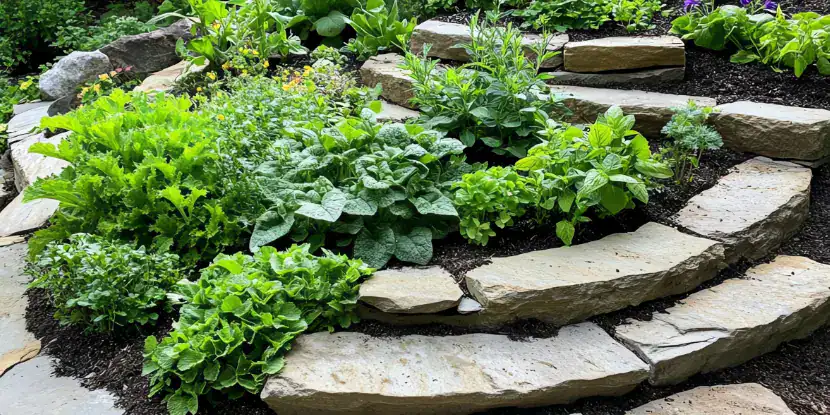
A tiered and spiraling herb garden.
Real-World Success Stories
- Beacon Food Forest in Seattle, Washington, is a community-driven project providing free food while demonstrating permaculture principles in an urban setting.
- Greening the Desert in Jordan has transformed a barren landscape into productive gardens using permaculture techniques. Despite minimal rainfall, the site now produces abundant food while improving soil conditions.
- Zaytuna Farm in Australia serves as a living laboratory for permaculture education and demonstrates how permaculture principles create productive, sustainable agricultural systems.
- Closer to home, the Rainbow Permaculture Farm in Fallbrook “cultivates a brighter future on 12 acres of land… promoting harmony between people, our planet, and all living beings.”
Why Permaculture Gardening Is Gaining Momentum
Several factors drive permaculture’s growing popularity among modern gardeners:
- Environmental awareness is rising as people recognize industrial agriculture’s ecological impact. Permaculture offers a viable alternative that builds soil health, sequesters carbon, and supports biodiversity.
- Food security concerns have increased in the wake of recent supply chain disruptions. Growing your own food provides independence from industrial food systems while ensuring access to fresh, nutritious produce.
- Urban sprawl continues to devour arable land. Homeowners are replacing water-hungry lawns with productive edible landscapes that require less maintenance and provide greater yields.
- Community building occurs naturally around permaculture projects. Community gardens, skill-sharing workshops, and local food networks strengthen social connections while promoting sustainable practices.
- Educational opportunities have multiplied via online platforms, certification programs, and local workshops. Universities and independent organizations now offer Permaculture Design Courses (PDCs) teaching comprehensive skills.
FAQs: Permaculture Gardening
Q: What’s the difference between permaculture and organic gardening?
Good question! Organic gardening avoids synthetic chemicals, while permaculture encompasses broader system design principles. Permaculture gardens are typically organic but emphasize energy efficiency, water conservation, and ecological integration.
Q: How much space do I need for permaculture gardening?
Permaculture principles apply to any space, from small balconies to large properties. Container gardens, vertical growing systems, and intensive planting methods maximize productivity in limited areas.
Q: Is permaculture more expensive than traditional gardening?
Initial setup costs may be higher due to infrastructure like rainwater collection and soil building. However, established permaculture systems are cheaper to cultivate than conventional gardens.
Q: How long does it take to establish a permaculture garden?
Mature food forests may take 5-10 years to develop, but many benefits become apparent within the first growing season.
Q: What plants work best for Southern California permaculture?
Mediterranean herbs, citrus trees, pomegranates, figs, native plants, and perennial vegetables like artichokes and asparagus are drought-tolerant options.
Q: Can I practice permaculture if I’m renting?
Many permaculture techniques work for renters, including container gardening, composting, and annual polycultures. Focus on portable systems and soil improvement that benefits current and future occupants.
Q: How does permaculture help with water conservation?
To minimize water usage, permaculture employs mulching, soil building, rainwater harvesting, greywater systems, and drought-tolerant plants.

